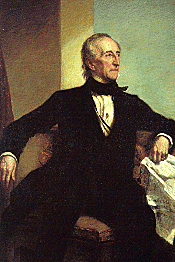| An Overview of John Tyler's Administration John
Tyler was the first Vice-President to become President
upon the death of the President, succeeding William Henry
Harrison barely a month after Harrison had taken
office. Originally a Southern Democrat, he had split with
his party to be Harrison's running mate, even though the
Whig program clashed with many of his lifelong beliefs.
As President, he soon became a man without a party. He
vetoed almost every important bill passed by Congress.
Angry Whigs tried to impeach him, the first such move
against a President. They failed, but the resulting
friction destroyed the Whig program. The Whig Party
dumped him from its ticket in 1844, making him the only
sitting President to not receive his party's nomination
for re-election (of those Presidents who actively sought
re-election).
Although historians once thought of Tyler as a
"mediocre man" at best, most now regard him as
a President of exceptional courage and imagination. He is
also respected as the man who firmly established the
right of the Vice-President to succeed completely to the
presidency. When he first took office, many Whig leaders
suggested Tyler be called only "Acting
President," but Tyler insisted on taking over the
office in fact as well as in name.
White House portrait of John Tyler

| Vice-President
and Cabinet |
| Vice-President |
none |
| Secretary of State |
Daniel Webster
Abel P. Upshur (1843)
John C.
Calhoun (1844) |
| Secretary of the
Treasury |
Thomas Ewing
Walter Forward (1841)
John C. Spencer (1843)
George M. Bibb (1844) |
| Secretary of War |
John Bell
John C. Spencer (1841)
James M. Porter (1843)
William Wilkins (1844) |
| Attorney General |
John J. Crittenden
Hugh S. Legaré (1841)
John Nelson (1843) |
| Postmaster General |
Francis Granger
Charles A. Wickliffe (1841) |
| Secretary of the Navy |
George Edmund Badger
Abel P. Upshur (1841)
David Henshaw (1843)
Thomas W. Gilmer (1844)
John Y. Mason (1844) |
| U.S.
Events During His Administration |
States
Admitted Florida
(1845)
Population in 1845 20,200,000 |
| 1841 |
The Oregon
Trail was blazed. |
| 1841 |
The entire Cabinet, with the
exception of Daniel Webster, resigned. |
| 1841 |
The Pre-Emption Act was passed
by Congress. |
| 1842-1844 |
Kit
Carson and John C.
Frémont explored vast parts of the West. |
| 1842 |
The Seminole War in Florida came
to an end. |
| 1842 |
The Webster-Ashburton Treaty
settled the boundary between Maine and Canada. |
| January 10, 1843 |
Whig leaders introduced
impeachment resolutions in the House of
Representatives. |
| 1844 |
Samuel
F.B. Morse successfully demonstrated his
telegraph before members of Congress. |
| March 1, 1845 |
Texas
was annexed into the United States. |
| World
Events During His Administration |
| 1841-1842 |
China
opened its ports to world trade. |
| 1843 |
The Hudson's
Bay Company founded Fort Victoria in Canada. |
| 1844 |
Gustave E. Pasch of Sweden
invented the safety match. |
| 1844 |
The YMCA was organized in
London. |
See Also
William Henry
Harrison
Daniel Webster
Florida
Oregon
Trail
Kit
Carson
John C.
Frémont
Samuel
F.B. Morse
Texas
China
Hudson's
Bay Company
Questions
or comments about this page?
|
